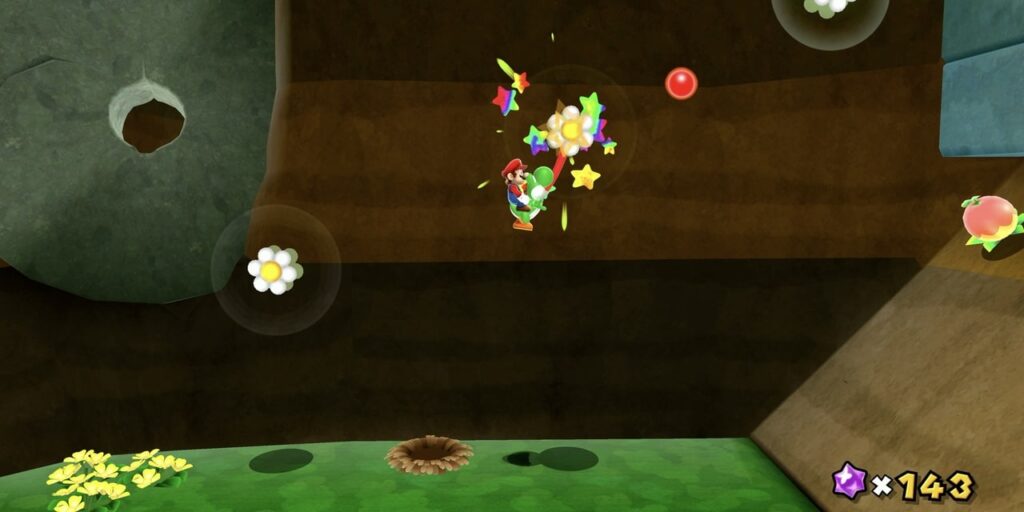It’s the big Four-Oh for Mario, and while that would signal a bit of a midlife crisis in many men, he’s already taken up all manner of sports, been an avid kart racer for decades, and even spends many a weekend playing board games. What else to do, then, but reminisce about that time he went to space in Super Mario Galaxy and Super Mario Galaxy 2?
This pair of games are rightly held up as two of the very best platformers of all time. Those opening hours of Mario Galaxy are still an absolute delight as you bounce between small celestial bodies, run any and all directions around oddly shaped planetoids and structures, head into a strange space pill for some gravity-shifting 2D platforming, and then still find that there’s more traditional feeling Mario levels as well. Well, about as traditional as you can be when you turn into Bee Mario and have to clamber around on a queen bee. Super Mario Galaxy 2 showed just how fertile this platforming concept was, adding Yoshi into the gameplay mix, using his tongue to grab things with the pointer, new power ups, and more.
Remastering these two beloved platformers is no small feat. One of the problems with Nintendo’s more experimental phase starting with the Wii and DS is how difficult it can be to translate their Wiimote pointer and touchscreen to more typical controllers. Mario Galaxy was built with the screen pointer in mind, to gobble up star chunks, fire them at enemies and interactive objects, grab onto items on screen and to trigger spin moves with a quick waggle (with a button press backup). It becomes even more integral in Galaxy 2 as you often rely on Yoshi to gobble things up and grab things with his tongue.
None of that’s a problem for the Switch or Switch 2, with motion sensors built into all the official controllers, and playing on a TV with Joy-Con in hand, moving with the left stick and pointing with your right hand, does a great job of capturing that original Wii feel – just tie the wrist straps together for a truly authentic Wiimote and nunchuck experience. The one thing missing is that you can’t use your right hand as a mouse pointer, which is reserved only for a player 2. I guess this might have required a few too many button remapping gymnastics. Playing with a Switch Pro Controller also works great, though it feels a bit more clumsy to be tilting both hands together to move that cursor.
The real pain point for the 35th anniversary 3D All-Stars rendition of Mario Galaxy came with the handheld experience. Here, instead of letting you tilt the console to move a pointer, you were forced to lift a hand and touch the screen to interact. That’s still an option with these 40th anniversary remasters, but now you can use motion as well.
The handheld experience is just one sign of a remaster that digs deeper and goes much further to make these two games feel as native as possible. It extends to many more areas as well, so while the menus still look and feel like Nintendo Wii menus with gigantic buttons you can point at or touch, the cursor can also snap to buttons when using an analogue stick. New and revised game options are built into the game’s menus instead of a Switch Online-like emulator overlay, you’re no longer prompted to save after every level completion, and there’s a whole new Assist mode that modifies the game with more health for Mario, health recovery when standing still, and easy recoveries from falls into oblivion.
And then there’s the graphical improvements. On Switch 2, you now have 1080p when playing handheld and a 4K output to TV. Nintendo’s aversion to anti-aliasing remains, but when the resolutions match your screens, it feels better, and it’s paired with revamped textures that generally feel like someone’s wiped the Vaseline off your glasses – other petroleum jellies are also available to smear on your glasses. Grass textures go from mottled colours to having more distinct shaped patches, or there’s now a checkerboard pattern overlaid on the sky of the Honeyhive Galaxy.
Is it perfect? Not quite. There are some texture swaps that shift in what feels like a less detailed direction, and there’s also places that aren’t improved, like Captain Toad’s very low poly count model, and I’d argue that the Switch 2 in particular should be able to handle a longer draw distance and remove some more shadow pop in.
I also feel like the pre-rendered cutscenes could have had a bigger improvement. They’ve been re-rendered and have an opened up aspect ratio, but they still come off as being relatively low resolution from the massive amounts of depth of field in place. Still, this is a generally handsome set of remaster works that (judging by the initial reaction to the announcement thinking that it was a simple upscaling) does a great job of capturing what you remember these games as having looked like 15+ years ago.
There’s not too much more to this bundle beyond that – a new storybook in Galaxy 2, for example – and that’s part of why the £34/$40 per game and £59/$70 combined pricing might feel steep. In truth, it’s in keeping with the Metroid Prime remaster, per game, and if you’re still into physical games, you can get a good few quid off that way.








What a fun celebration of Mario’s 40th! It’s great to see how these classic games continue to resonate with fans. The thoughtful review captures the essence of what makes the Super Mario Galaxy series so special.
Absolutely! It’s impressive how Mario’s adventures have evolved while still keeping that nostalgic charm. The innovative level design in both Galaxy games really showcases the creativity that keeps players engaged, even after all these years.
I completely agree! It’s fascinating how the gameplay mechanics have advanced, yet the charm and creativity remain intact. The way they introduce new power-ups and worlds while honoring the classic elements really showcases the series’ ability to innovate.
Absolutely! The blend of innovative gameplay with that classic Mario charm really makes these games timeless. It’s interesting to see how they balance nostalgia with fresh ideas, appealing to both new and longtime fans.
I completely agree! The creativity in level design truly sets these games apart, allowing players to explore unique mechanics in each world. It’s impressive how they balance nostalgia with fresh experiences.
Absolutely! The imaginative use of gravity in levels really adds a unique twist to gameplay, making each world feel fresh and exciting. It’s amazing how much depth the developers packed into both games.
I completely agree! The gravity mechanics not only enhance the challenge but also encourage creative problem-solving. It’s fascinating how each level feels like a mini-puzzle, keeping the gameplay fresh throughout the experience.
Absolutely! The gravity mechanics really do add a unique layer to gameplay, making each level feel like a new puzzle. It’s fascinating how they encourage players to think outside the box and explore different strategies. Plus, the visuals are stunning—definitely a feast for the eyes!
I completely agree! The gravity mechanics not only enhance the gameplay but also encourage players to think creatively about their approach to each level. It’s fascinating how these elements transform traditional platforming into something truly innovative.
Absolutely! The gravity mechanics really add a unique dimension to the platforming experience. Plus, they encourage players to think creatively about navigating the levels, making each challenge feel fresh and engaging. It’s impressive how these games continue to innovate even after all these years!